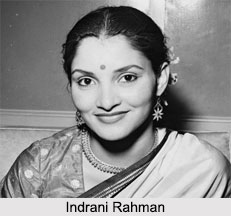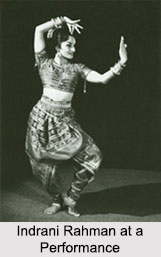 drani Rahman was an Indian classical dancer. She mainly performed Bharata Natyam, Kuchipudi, Kathakali and Odissi. She was one of the key artists from India who popularized these dance forms in the west. A winner of 1952 Miss India pageant, she joined her mother Ragini Devi`s dance company. The mother daughter duo performed classical dances in various parts of India and the world. Indrani was the recipient of various prestigious awards including Sangeet Natak Akademi Award.
drani Rahman was an Indian classical dancer. She mainly performed Bharata Natyam, Kuchipudi, Kathakali and Odissi. She was one of the key artists from India who popularized these dance forms in the west. A winner of 1952 Miss India pageant, she joined her mother Ragini Devi`s dance company. The mother daughter duo performed classical dances in various parts of India and the world. Indrani was the recipient of various prestigious awards including Sangeet Natak Akademi Award.
Early Life of Indrani Rahman
She was born on September 19, 1930 in Chennai, British India to Ramalal Balram Bajpai and Esther Luella Sherman. Her father was an Indian nationalist and president of the Indo-American League. Her mother was born in Petoskey and changed her name to `Ragini Devi` once the couple moved to India, in 1920s.
 Career of Indrani Rahman
Career of Indrani Rahman
Indrani started learning dance at the age of 9 years from her mother. She accompanied her as she travelled through, America and Europe. Later, she learnt the Pandanallur style of Bharata Natyam from Guru Chokkalingam Pillai. Indrani Rahman started her professional career with Bharata Natyam in 1940s. Soon she started learning Kuchipudi from Korada Narsimha Rao. With Narsimha Rao she later toured many parts of the world.
In 1947 mesmerized by her dance performances, India`s leading dance and art critic Dr. Charles Fabri encouraged her to learn Odissi. She was the first professional dancer to learn Odissi. She learnt the art from notable Guru Sri Deba Prasad Das. Through her performances, she popularized this little known dance form in India and the world. In 1952, she participated and won the Miss India title and went on to compete in the Miss Universe 1952 Pageant which held at Long Beach, California. In 1961, she became the first dancer to be present on a national tour by the Asiatic Society. She also performed for US President John F. Kennedy and Prime Minister Jawaharlal Nehru, during Nehru`s official visit to Washington, D.C. She became a faculty member of the dance division at the Juilliard School at New York`s Lincoln Center for the Performing Arts in 1976.
Achievements of Indrani Rahman
Indrani Rahman was awarded with these following recognitions:
•Femina Miss Indian in 1952
•Padma Shri Award in 1969
•Sangeet Natak Akademi Award in 1981
•Taraknath Das Award
Personal Life of Indrani Rahman
She married Habib Rahman a well-known architect in 1945. The couple had a son and a daughter namely Ram Rahman and Sukanya Rahman (Wicks). Her son was an artist and her daughter also danced with her mother and grandmother. Her grandsons are Wardreath Wicks and Habib Wicks. She breathed her last on February 5, 1999 in Manhattan, New York.



















